Definition of illness. Causes of the disease
Dental caries is a typical pathological process that has formed in the course of evolution as a response of the hard tissues of the tooth to various factors of influence, which gradually lead to the formation of a dental defect in the form of a cavity.
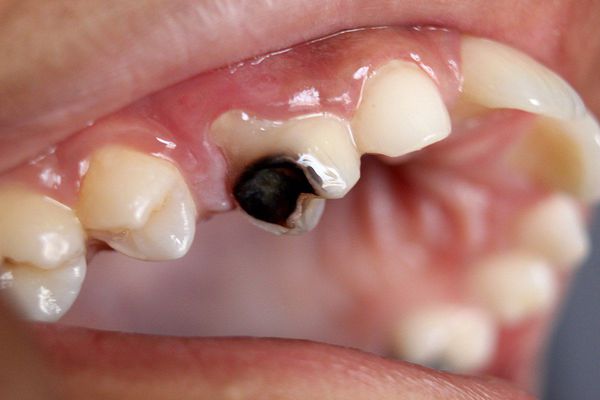
The causes of caries come down to two etiological factors:
- General factors:
- Malnutrition and diet. The lack of a whole complex of vitamins and minerals leads to disorganization of the tooth structure. However, a huge role is played by the pathological effects of easily digestible carbohydrates, the nature and diet, as well as the fluorine content in drinking water.
- Somatic diseases directly related to the development and formation of the tooth and its elements, which can cause functional and structural changes.
- The influence of damaging environmental factors that have an extreme effect on the macroorganism (overheating, frostbite, etc.).
- Hereditary factors associated with the full formation of the structure and chemical composition of tooth tissues.
- Local factors:
- Dental plaque rich in microorganisms.
- Exposure to the composition of the oral fluid, which can change as a result of various diseases.
- Consistency of local protective mechanisms of tooth tissues, their resistance (stability).
- The condition of the pulp is the connective tissue that fills the cavity of the teeth.
- Normal laying and maturation of the dentoalveolar system.
- Deviations in the biochemical composition of the tissues of the tooth.
E-cigarette smoking can also lead to the development of caries. According to scientists, vaping liquid is an excellent substrate for the growth of bacteria that cause cavities [14] .
Some sources highlight the neurotrophic theory of caries development, the theory of proteliosis and chelation, Miller’s theory, Lukomsky’s theory. These theories are outdated and are not relevant at the moment.
Caries can occur at any age. Most often, it gradually appears in adults at the age of 35-44. Children are especially predisposed to the appearance of caries, since the enamel of milk teeth is much more sensitive than the enamel of molars. [eleven]
Causes of the development of pathology in children
The causes of caries in children are the same as in adults, but caries in children develops rapidly. The reason for the rapid development is the demineralized immature enamel of children. Caries is usually white – it develops so quickly that it does not have time to stain with pigment. Due to immature dentin, if caries has gone beyond the border of enamel, the child will definitely develop pulpitis .
Symptoms of dental caries
It is important to understand that the appearance of caries can be both an acute current process and a chronically developing one. In the first case, we are talking about hereditary failure of the strength and stability of tooth tissues. The chronic process occurs as a result of prolonged exposure to local and general damaging factors.
As a rule, the disease occurs gradually, since compensatory-adaptive mechanisms protect the body from unpleasant symptoms for a long time. However, at a certain point they still fail, and the first signs of caries appear in the form of unpleasant sensations in the oral cavity when eating cold, hot, spicy, sour or sweet foods. Further progression of the disease leads to the development of plaque and the appearance of tartar, worsening the condition of the oral cavity.
Another important symptom is the presence of carious spots, which at first are single, but gradually their number and area increase. The color of the tooth itself is not changed, except for the affected area.
With a slow course of the carious process, the lesion is colored yellow or dark brown. With the rapid course of caries, which is more often observed in children due to the increased permeability of the tissues of milk teeth and the individual reactivity of the body, the affected areas are light. The mucosa in the surrounding tissues of the tooth during caries is not changed, tapping on the tooth is painless. [8]

The clinic of carious lesions is also characterized by the occurrence of localized pain when exposed to an irritant, after the removal of which the pain quickly subsides. This symptom occurs when caries penetrates the dentin. [five]

The pathogenesis of dental caries
Currently in medicine there are a huge number of theories of the occurrence of caries. The generally accepted is the multifactorial theory , according to which the demineralization of hard tissues of the tooth proceeds under the influence of microorganisms that accumulate in plaque. [5] The result of their vital activity leads to the formation of organic acids that destroy the protective elements of dental tissue.
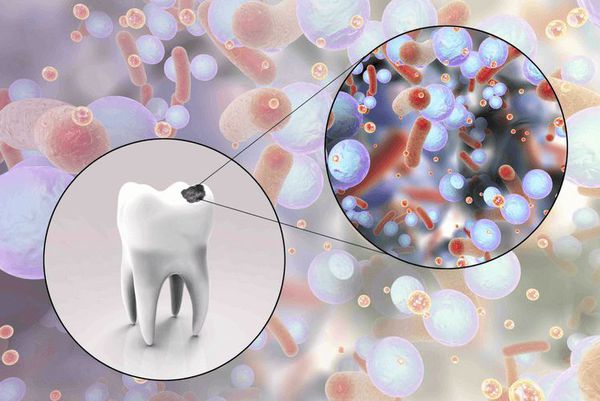
The formation of caries is based on a carious situation, which gives rise to the formation of a carious spot.
Stages of dental plaque development:
- Pellicle is an organic film that forms on the surface of the tooth within minutes and hours.
- The growth of bacterial colonies occurs during the first few days immediately after adsorption (absorption) on the surface of the pellicle of epithelial cells and microorganisms.
- Mature plaque stage – gives rise to the progression of caries
The rate of development of this process directly depends on the nature of the food and the quality of oral hygiene. This is why daily brushing of your teeth is so important.
Classification and stages of development of dental caries
There are the following types of caries:
- By the nature of the affected tooth:
- caries of milk teeth;
- caries of molars (permanent) teeth.
- According to age characteristics of occurrence:
- juvenile caries – occurs at a young age;
- senile caries – occurs in adulthood.
- Depending on the initial link of the lesion:
- primary caries – the formation of a carious defect on a healthy tooth enamel that has not previously been treated;
- secondary caries – the occurrence of caries on a sealed treated tooth (a carious lesion that has arisen around the focus of a previously stopped carious process, in the area of pulpless teeth and caries located under an artificial crown).
- By the presence or absence of complications:
- complicated caries – a carious process with the development of periodontitis and pulpitis;
- uncomplicated caries.
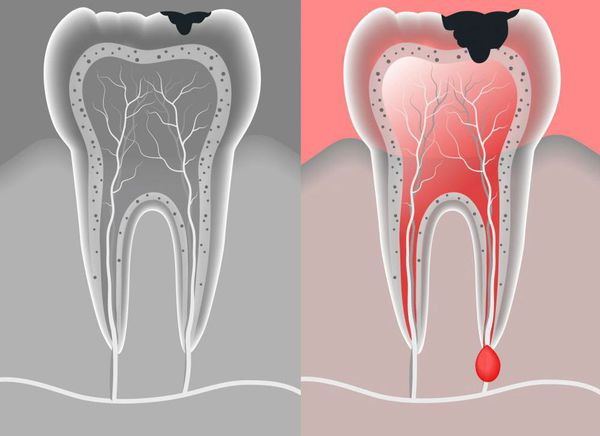
- By the number of affected teeth:
- single caries – no more than five teeth are affected;
- multiple caries – more than five teeth are involved in the carious process.
There is also the concept of “blooming caries” – an acute process that affects most teeth.

Anatomists divide caries into:
- tooth crown caries;
- caries of the neck of the tooth;
- root caries.
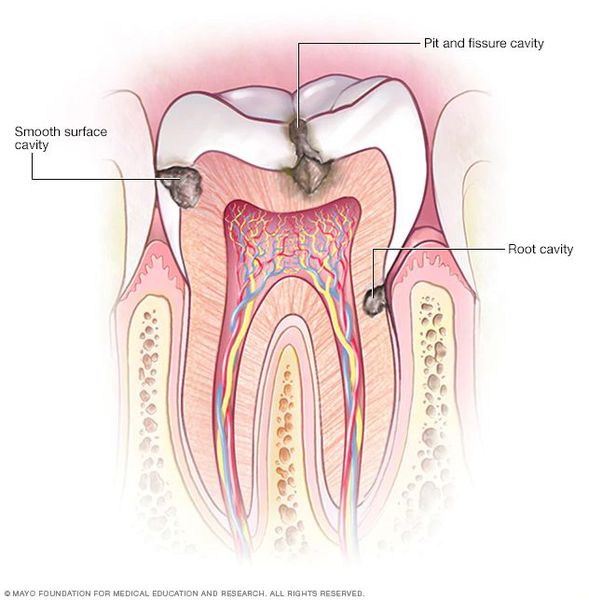
Caries can affect different parts of the teeth, so four forms of caries are distinguished according to the location :
- fissure caries – carious lesions of the surface of chewing teeth and premolars;
- proximal caries – occurs between the teeth;
- cervical caries – formed in the neck of the tooth;
- circular caries – a carious lesion encircling the area of \u200b\u200bthe neck of the tooth.

According to the stage of development – depending on the depth of the lesion and the speed of the course of the carious process, there are four forms of caries:
- Initial caries or carious spot – no complaints; a chalk-like stain is found on the surface of the tooth.
- Superficial caries – only the enamel of the tooth is affected; complaints are either absent, or there is pain from chemical and thermal stimuli.
- Medium caries – the enamel and the surface layer of dentin are affected; the pain reaction may not be expressed or may arise from eating and mechanical irritation when opening the carious cavity.
- Deep caries – the enamel and a significant layer of dentin are affected, but its thin layer remains above the tooth cavity; pains arise from the action of mechanical, chemical and thermal stimuli; with a long course of the carious process, pain symptoms are less pronounced.
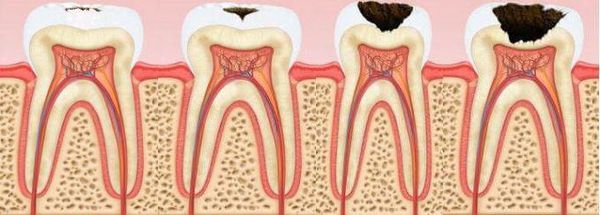
Along the course, acute and chronic forms of caries are distinguished. At the same time, one should not forget about the most acute and asymptomatic forms of the disease.
The World Health Organization also has its own classification, according to which caries is divided into:
- initial caries;
- enamel caries;
- dentine caries;
- cement caries;
- suspended caries (when the carious process is stabilized). [2]
It should also be noted that there are caries-susceptible zones. In this regard, caries can be:
- typical – located in the natural recesses of the teeth, contact surfaces, as well as in the cervical areas;
- atypical – most often localized in areas resistant to the formation of caries, for example: the equator, mounds of chewing teeth, oral surfaces of the teeth, in the zone of the tooth root.
Complications of dental caries
Quite often, patients ignore the first manifestations of caries, in connection with this, the disease progresses, the carious plaque increases, and microorganisms penetrate deep into the tooth.
What happens if caries is not treated
If caries is not treated, then complications arise: pulpitis , periodontitis and granuloma.
One of the most common complications of untimely visits to the doctor is pulpitis – diffuse inflammation of the tooth pulp, which is localized inside the cavity and gradually leads to thinning of the dentin and enamel.
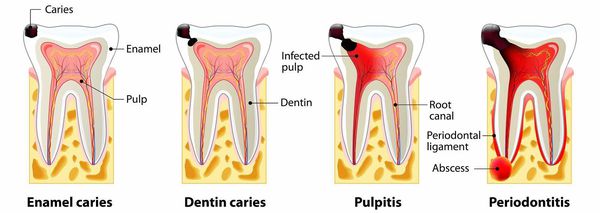
Further progression of pulpitis can lead to periodontitis – further inflammation that spreads to the bone tissue surrounding the tooth. In this case, the patient has general and local symptoms of inflammation:
- fever;
- swelling;
- sharp throbbing pain when pressed;
- swelling of the gums.
In this case, a visit to the doctor is necessary, since periodontitis can become the initial link in the process of acute purulent inflammation, leading to osteomyelitis (bone inflammation) of the jaw and a generalized infection of the whole body – sepsis.
Chronically current periodontitis can cause the formation of granulomas – small nodules filled with inflammatory elements. Their occurrence is an urgent indication for treatment, as they can progress to the development of periostitis, and later phlegmon – diffuse acute inflammation. [6]
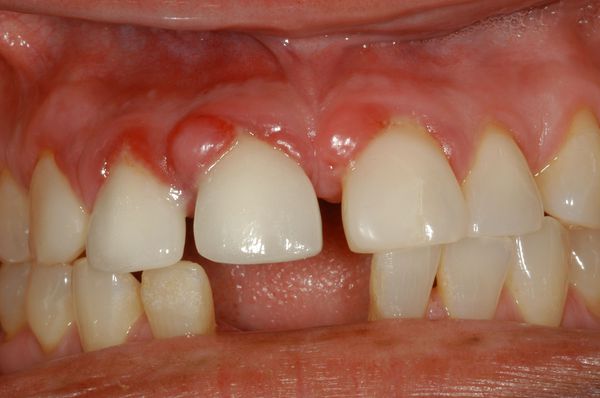
Unfortunately, not all patients understand the need for timely treatment of caries. However, complications of caries can sometimes lead to irreversible secondary changes and a deterioration in the quality of human life.
Diagnosis of dental caries
As you know, timely diagnosis always contributes to a more favorable outcome of the disease. In the practice of a dentist, there is a large arsenal of various methods for the differential diagnosis of caries. For this, general and additional methods are used. [8]
General diagnostic methods:
- Examination and questioning of the patient . Despite its simplicity, it is of great importance and requires the care and knowledge of a doctor. The dentist conducts an examination using a mirror, carefully examining each tooth for the presence of carious cavities and stains, as well as the changed color of the tooth. During the questioning, the dentist must find out what complaints the patient has addressed, find out about the presence of pain, under what conditions they occur and about their nature.
- Percussion . Tapping allows the doctor to form an idea of the nature of the pain, its irradiation and localization, as well as to identify induration, granulomas, etc.
- Sounding . This diagnostic method is a more advanced method of examination. It is performed using a special device – a probe, which allows the doctor to more accurately determine the degree of caries and its localization.
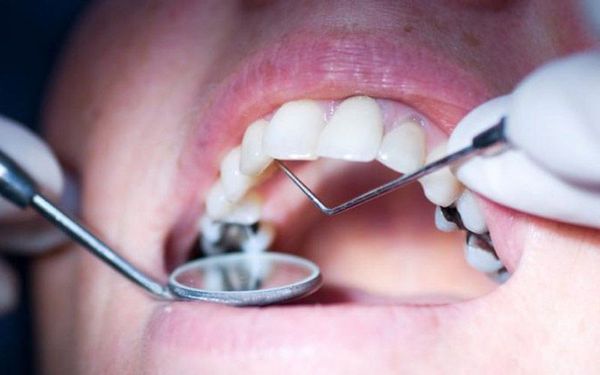
- Thermal test . It belongs to the most accessible diagnostic methods, as it is carried out using a jet of cold water or cotton balls soaked in special solutions. A thermal test allows you to understand the degree of pain in the tooth and check the stability of the dental tissue in response to a cold (most often) stimulus.
Additional diagnostic methods :
- Electroodontometry . It is the effect of electric current on the pulp of the tooth, it is needed to determine the condition of the pulp (nerve endings) of the tooth. The advantages of this method are in determining the minimum current strength to which the tooth pulp responds. Low values are typical for intact pulp, high values for damaged tissue with reduced sensitivity.
- Vital staining . This method was proposed by Doctor of Medical Sciences E.V. Borovsky. It is carried out as follows: the tooth is pre-cleaned and dried, then a dye is applied to it (most often methylene blue), as a result of which carious spots and cavities are stained.

- Transluminescence . The study is carried out in a dark room, a dye is preliminarily applied to the teeth. Carious formations differ from healthy areas in the presence of dark spheres.
- luminescent method . It is based on the passage of ultraviolet light through the dental tissue. At the same time, healthy teeth remain light, and those affected by caries become dark.
- Determination of the electrical resistance of solid tissues . Due to the loss of mineral components, teeth affected by caries, when exposed to electric current, have a lower electrical resistance compared to healthy teeth.
- X-ray diagnostics . It is one of the earliest and simplest studies. It allows you to identify structural changes in the tissues of the tooth and hidden carious cavities.
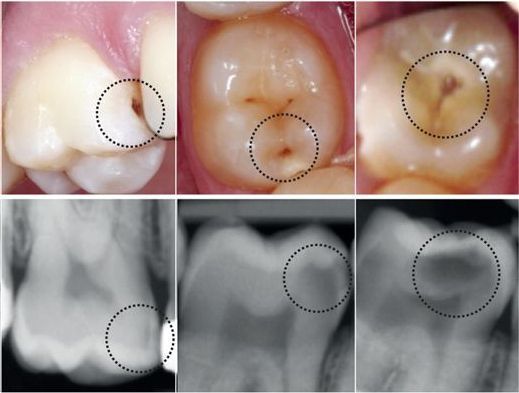
Treatment of dental caries
Treatment options for caries in dentistry include invasive and non-invasive procedures.
Treatment methods for the initial and superficial stages of caries
Non-invasive methods are certainly easier for both the doctor and the patient. Their essence lies in the remineralization therapy of caries (restoration of mineral balance). However, such treatment is possible only at the initial stages of caries development, when there are no visible defects yet, and only the dynamic balance between the content of organic acids and the mineral component of the tooth is disturbed.
Non-invasive methods include treatment with various preparations of calcium, fluorine and other mineral-containing substances. In practice, such drugs as calcium gluconate, remodent, calcium glycerophosphate, calcium hydroxide, sodium fluoride, fluorine-containing gel are most often used. Methods of their use are different: from rubbing a fluorine-containing gel to the introduction of calcium and fluoride preparations into the tooth tissue using electrophoresis.
The course of remineralizing therapy consists of 15-20 procedures.
Also an important method of treatment is professional oral hygiene, which consists in cleaning hard-to-reach areas of the oral cavity from food residues.
Methods for the treatment of caries of the middle and deep stages
Invasive methods are used in cases where the process of caries formation extends into the deeper layers of tooth tissues. There are no differences in the methods of treatment of medium and deep caries. In both cases, “preparation followed by a filling” is used.
This treatment has the following goals: removal of necrotic masses, application and fixation of a filling, restoration of the anatomical structure of the tooth. This process takes place in several stages: [6] [8]
Treatment of caries with a drill
The standard protocol for the treatment of caries includes the following steps:
- opening of the carious cavity with the help of a spherical and fissure bur;
- expansion of the carious cavity to prevent secondary caries (most domestic authors adhere to the methodology of I.G. Lukomsky);
- necrotomy followed by removal of destroyed and softened dentin;
- giving the carious cavity the shape of a geometric figure;
- preventive treatment of enamel edges;
- antiseptic treatment of the cavity;
- filling using an adhesive protocol.
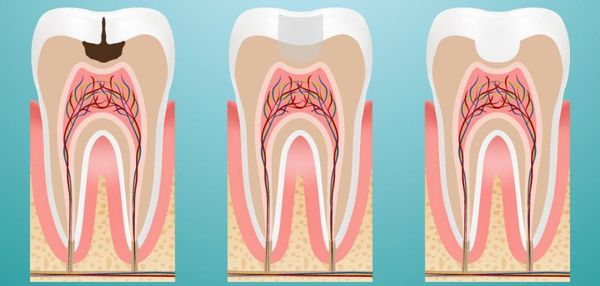
Treatment of caries without a drill
The laser method is used very rarely – instead of mechanical treatment (drill), the affected tissues are removed with a laser beam. Then the standard protocol for the treatment of caries is carried out.
The air-abrasive method is used for fluorosis . The treatment of the carious cavity is carried out with an air jet under high pressure.
Ozone therapy. The procedure is based on the treatment of the affected surface with ozone. However, there is no convincing evidence that applying ozone to the surface of decayed teeth stops or cures caries [12] .
ICON . If caries is in the stain stage, then its development can be stopped by the modern ICON treatment method. The treatment includes the use of three components: acid, alcohol, and a special resin. If the carious lesion is only within the enamel (no dentine lesion), then the microbial invasion between the prisms can be “etched out” and filled with resin, which photopolymerizes after application. The development of caries completely stops.
Treatment of caries during pregnancy
Pregnancy is not a contraindication for dental procedures. Local anesthesia may be used during treatment. A single x-ray examination does not affect the incidence of congenital anomalies of the fetus and does not increase the incidence of miscarriage [13] .
How to get rid of caries yourself
Cure caries alone will not work. Timely access to a specialist will prevent the adverse effects of caries.
Forecast. Prevention
The prognosis of caries depends on the depth of destruction that affected the tooth tissue, but in general it is favorable due to the development of treatment methods and timely diagnosis.
As you know, the best method of treatment is the prevention of the disease. In particular, caries prevention can be divided into endogenous (internal) and exogenous (external). [6]
Endogenous prophylaxis :
- Correction of the diet – proper nutrition, which includes all the necessary micro and macro elements. It is one of the fundamental principles of caries prevention, especially in children and people with reduced body resistance.
- The use of high-quality drinking water containing the necessary mineral salts.
- Taking various drugs that strengthen dental tissue.
- Eating the most important vitamins for dental tissue – A, B, C, D.
Exogenous prophylaxis :
- Fluoroprophylaxis and remineralization.
- Use of special preventive toothpastes.
- Fissure sealing.
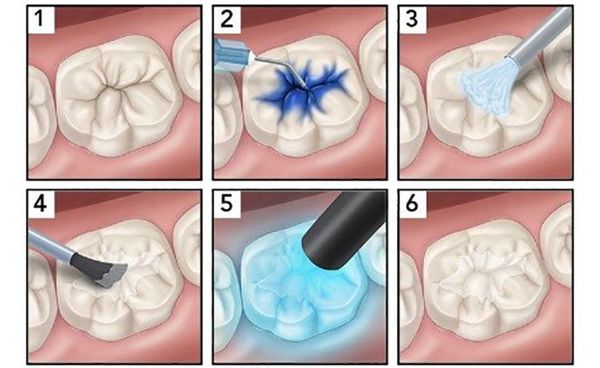
One of the most important aspects of the prevention of dental diseases is the sanitation (improvement) of the oral cavity. It includes several stages:
- examination of the oral cavity;
- treatment of both milk and permanent teeth;
- elimination of areas affected by infectious agents;
- treatment of affected mucous membranes;
- correction and prevention of deformation of teeth and jaws;
- periodic and planned medical examinations.
How to brush your teeth and how to rinse your mouth
Teeth should be brushed twice a day after meals with “sweeping” movements – from the gums to the crown of the tooth. In each area, 5-10 movements are made with a brush – first from the vestibular (tooth surface facing the outside), then from the lingual side. The cleaning of the teeth ends with the treatment of the contact surface. Be sure to clean the interdental spaces using interdental toothbrushes, floss (floss) and an irrigator.
For rinsing your mouth, you can use rinses bought at a pharmacy or in specialized stores. Rinse aid, depending on the components included in its composition, has a bactericidal effect and reduces the density of plaque on the teeth.
Special toothpastes to remove plaque from teeth
All modern toothpastes contribute to the removal of plaque. Toothpastes containing fluoride and calcium help to cope with the demineralization of enamel prisms. But you have to be careful with fluorosis – in this situation, fluoride products are prohibited.
Gels and rinses
Gels and rinses containing sodium fluoride, zinc chloride, chlorhexidine and other components have an anti-inflammatory effect, increase the resistance of tooth enamel to acids, restore the mineral saturation of teeth and prevent caries.
